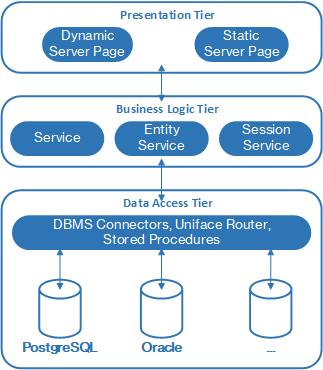Multi-Tier Applications
Uniface applications are typically multi-tier applications, which are split into separate layers for the user interface (presentation), business logic, and data access.
Uniface enable you to create components that fill one or more roles in a multi-tier application.
- Presentation Tier—components that are responsible for the user interface. For web applications, you can use Dynamic and Static Server Pages, forms, and reports. For more information, see Presentation Tier.
- Business Logic Tier—components that handle business rules and task-specific behavior. In Uniface, the business logic tier is typically composed of Services that can be remotely executed on a server. These services can include specialized components called Entity Services and Session Services, which centralize business rules for single or multiple entities. Network and middleware access is encapsulated by the middleware drivers and the Uniface Router. For more information, see Business Logic Tier.
- Data Access Tier—physical database structures are modeled as Uniface data entities. Uniface ensures physical data access by encapsulating SQL in its DBMS connectors. For more information, see Data Access Tier.
Each application tier needs to be composed exclusively of replaceable components that communicate via well-defined signatures. This can also include non-Uniface components. It is therefore essential to construct components for each tier using component-based development methodology.
Ideally, it should be possible to deploy multi-tier applications on n-server, n-client networks, with the presentation tier being readily deployable across the Internet. Uniface supports such a distributed environment, including XML and JSON streams for transparent communication with Internet-based rich client components.

